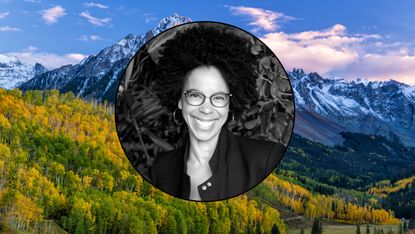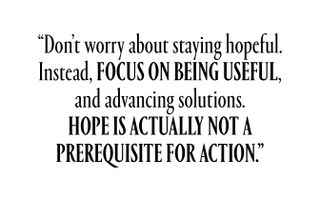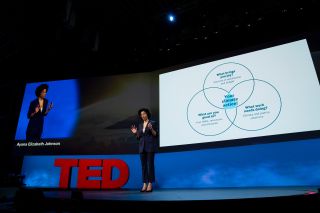The realities of global warning are becoming increasingly dismal. But in her latest book 'What If We Get It Right?' Dr. Ayana Elizabeth Johnson explains that we already have the answers we need.

(Image credit: Getty Images/Shutterstock)
By Leah Thomas
published 17 September 2024
in Features
Imagine this: No wildfires. Or 100-year-hurricanes or droughts or floods every year. Our coral reefs are vibrant; the microplastics are gone. There is sustainable public transportation, clean energy, and lush landscapes.
With the facts of climate change—an ever-warming world, climate-destroyed communities, rapidly-dwindling natural resources—it can be hard to imagine. Or it feels just that, imaginary. And it’s enough to make taking any meaningful action to “save the planet” so lofty and vast, it can feel pointless.
Talk to Ayana Elizabeth Johnson, Ph.D., a marine biologist and climate activist, and a different story emerges. She is the founder of the Urban Ocean Lab, an organization that works to help plan for the future of coastal cities, and has worked with everyone from Patagonia to the U.S. government to develop clean ocean policies. While Dr. Johnson doesn’t belittle the big problems climate change presents, she also believes them to be solvable.
It’s a topic Dr. Johnson explores in her recently published book, What If We Get It Right? Here, she shares that while a utopian world may not be the future, the apocalyptic visions we're all prophesying aren’t either.
Leah Thomas: What drew you to the world of marine biology and environmentalism?
Ayana Elizabeth Johnson: From a very young age, what drew me to it is love. I fell in love with nature—sea urchins, worms, butterflies, reef fish, stars, sunshowers, forests, moss. Once I learned that the species and ecosystems I loved were threatened, I became determined to do what I could to protect and restore nature.
Marine biologist was my first dream job, then park ranger, and later I wanted to be an environmental lawyer. Now I do ocean climate policy work for coastal cities through my think tank, Urban Ocean Lab, and also do what I can to welcome others into pro-nature actions and furthering climate solutions.
Stay In The Know
Marie Claire email subscribers get intel on fashion and beauty trends, hot-off-the-press celebrity news, and more. Sign up here.Contact me with news and offers from other Future brandsReceive email from us on behalf of our trusted partners or sponsorsBy submitting your information you agree to the Terms & Conditions and Privacy Policy and are aged 16 or over.
LT: Are there some positive ways you've seen the environmental movement shift over the decades?
AEJ: It’s great how multigenerational the environmental movement has become. Although I’d love to see more cross-generation collaboration, the fact that we are three (maybe four) generations deep holds heaps of potential.
I’m also starting to finally see the environmental movement become more prominent in mainstream pop culture. Better late than never, the status quo has shifted toward sustainability and climate action being a no-brainer. Like, of course we should all be helping to safeguard life on this rad, unique planet.
LT: Speaking of generations, an increasing number of young people are experiencing anxiety around the future of the planet. What would you say to someone who feels apathy towards action?
AEJ: I would say, don’t worry about staying hopeful. Instead, focus on being useful, and advancing solutions. Hope is actually not a prerequisite for action.
And while young people may feel generally misunderstood by older generations, I'd encourage them to seek out those older people who do want to understand them, and more importantly, who are open to mentorship. This can work both ways— each generation has a lot to learn from the others.
Find your people. Join something. Getting involved in climate solutions is not about quitting your job or starting your own nonprofit. It’s about finding your role, putting your skills, resources and magic to its best use— at home, at work, and as a citizen. One simple way I like to envision that is through what I call my climate action Venn diagram. It's where we each find our way to the intersection of three questions: What are you good at? What work needs doing? What brings you joy?

(Image credit: Getty Images)
LT: You’ve done a lot to spark conversations around climate change, including with your recent book What If We Get It Right? What inspired you to tell this story?
AEJ: Nature, biophilia, my love of and reverence for wonders of biodiversity and ecosystems; they're all an endless source of inspiration. I wanted to offer something toward the next shift I’d like to see in the environmental movement, which is toward a relentless focus on solutions, on imagining and building the future we want to see, instead of focusing on apocalyptic visions of the future we want to avoid.
I think having more and more answers to this “what if we get it right?” question is a critical component in inspiring all of us to charge ahead with the transformation that is needed, from an extractive economy and society to a regenerative one.
LT: The book has dozens of contributors from different walks of life—from activists to scientists to corporate sustainability leaders. Why was it important for you to include such a broad range of voices?
AEJ: As I put it in the book’s introduction, “If ever there were a moment for collective wisdom, this is it. All hands (and minds and hearts) on deck.” Climate change is the gnarliest, most gargantuan problem humanity has ever faced. We need hundreds of solutions. Through interviewing a wide variety of experts making major moves, people who have helped me see the ways forward, I want to highlight the breadth of the solutions needed.
I also want to be very clear that we already have most of the solutions we need—from restoring ecosystems, to green buildings, to public transit, to reducing food waste, to renewable energy. We just need to implement them...quickly!

(Image credit: Gilberto Tadday)
LT: You've helpfully included a playlist for the readers.
AEJ: The very last page in the book is my Anti-Apocalypse Mixtape. I probably spent 80-plus hours crafting it over the last six months, and listened to it on repeat while making my final edits. These aren’t songs written about climate, but ones I have repurposed because of the lyrics or energy they offer—anthems for victory, love songs to Earth, tunes for tenacity, and sexy implementation vibes.
LT: One argument against “climate optimism” is that it ignores the "reality" of the state of the world. Can you be a realist and a climate optimist at the same time, and if so, how do you balance the two?
AEJ: Personally, I’m not an optimist. I’m a scientist, a realist. The reality is that while the situation is dire, and the stakes are sky high, we also know that there are innumerable possible futures. So, while I don’t embody the optimistic expectation that our story on this planet has a happy ending, every day I wake up, as I think more and more of us wake up, and make increasingly devoted contributions to shaping the best possible climate future. And you know what? Even regardless of the outcome (which we can’t control), it will feel so incredibly good to have been part of the effort (which we can). Truly, every tenth of a degree of warming we can prevent, every centimeter of sea level rise we avoid, every bit of nature we protect and restore, really matters.
This story appears in the 2024 Changemakers Issue of Marie Claire.

The September 2024 Changemakers Issue
Leah Thomas is a celebrated environmentalist, founder of the non-profit, Intersectional Environmentalist, and author of The Intersectional Environmentalist: How to Dismantle Systems of Oppression to Protect People + Planet. She is based in Los Angeles, CA.
No comments:
Post a Comment